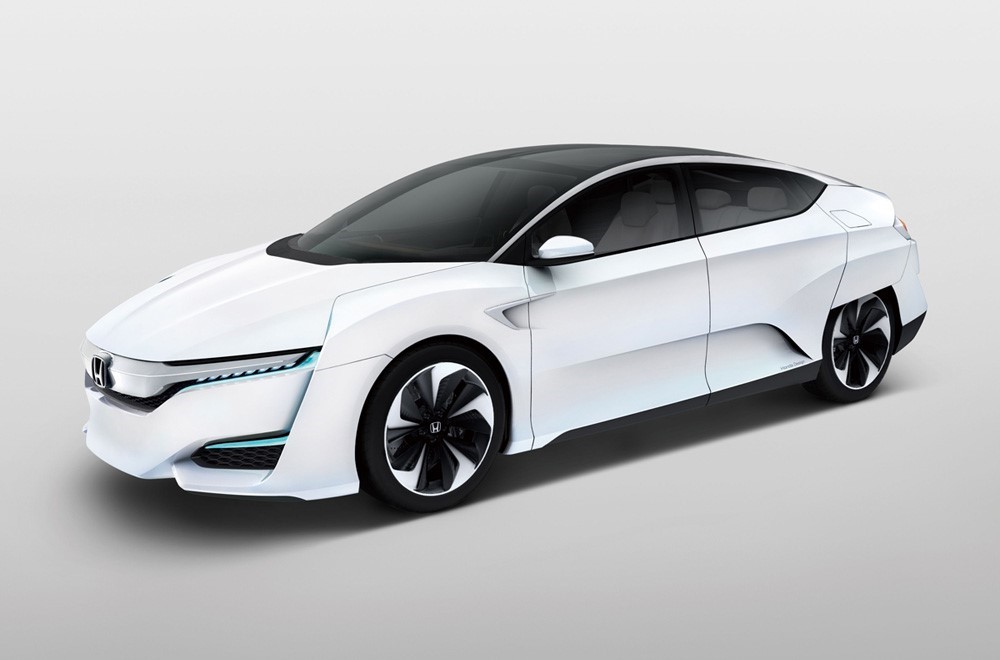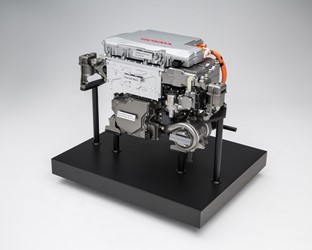HONDA FCV CONCEPT POINTS TO FORTHCOMING ‘HYDROGEN SOCIETY’

- Demonstrates evolution of next-generation fuel cell vehicle
- Previews production fuel cell vehicle due to launch in 2016
- Part of Honda’s contribution to the forthcoming ‘hydrogen energy society’
- Continues an unrivalled track record in fuel cell vehicle development
The Honda FCV CONCEPT, unveiled in Tokyo in November 2014, makes its European debut at the 2015 Geneva Motor Show.
The futuristically styled FCV CONCEPT previews an all-new fuel cell road car that is scheduled to go on sale in Japan in the first half of 2016, and subsequently in the USA and Europe within the following 12 months.
Next generation technologies for greater performance
Honda’s next-generation fuel cell vehicle will succeed the brand’s two previous production fuel cell cars, the FCX and FCX Clarity, and will feature significant improvements in performance and costs. The newly-developed fuel cell stack installed in the FCV CONCEPT is 33% smaller than its predecessor, and yet realises an output of more than 100 kW and an output density as high as 3.1 kW/L. This contributes to an overall performance improvement of approximately 60%.
At its launch next year, Honda’s third production fuel cell vehicle will be the world’s first[1] fuel cell car with the entire powertrain, including the downsized fuel cell stack, housed under the bonnet of a conventional sedan body shape. This packaging layout enables designers and engineers to develop a full cabin package that seats five adults comfortably. This in turn provides a future pathway to evolve Honda’s fuel cell-specific platform to provide the foundation for further body styles, which will contribute to promoting the more widespread acceptance and adoption of this zero emissions technology by an ever broadening section of motorists.
The Honda FCV CONCEPT is equipped with a 70 MPa high-pressure hydrogen storage tank that provides a cruising range of more than 700 km[2] (435 miles). The tank can be refilled in approximately three minutes[3], making refuelling as quick and easy as today’s conventionally-fuelled cars.
Developed in conjunction with ‘hydrogen society’ enabling technologies
As part of its holistic approach to promoting the adoption of the forthcoming ‘hydrogen energy society’, Honda continues to tackle the challenges facing the uptake of the fuel cell vehicle by developing new enabler hydrogen technologies beyond the vehicle itself.
One such innovation installed in the FCV CONCEPT is the Honda Power Exporter Concept, an external power feeding function[4], which underwent a large number of verification tests with the FCX Clarity. This system enables the car to function as a small mobile power plant that generates and provides electricity to the community in times of disaster or other events. It is capable of producing up to 9kW[5] of AC power.
Furthermore, Honda will continue to promote the application of the Smart Hydrogen Station (SHS), a packaged hydrogen station unit that adopts Honda’s original high-differential-pressure electrolyser.
Together, the Power Exporter Concept, FCV CONCEPT and Smart Hydrogen Station embody Honda’s vision for the forthcoming ‘hydrogen society’, respectively representing the ‘generate’, ‘use’ and ‘get connected’ functions. Through these interrelated technologies, and other research and development activities, Honda is working tirelessly towards a CO2-free society.
Honda’s pioneering track record in fuel cell vehicle technologies
Honda views hydrogen as a high-potential, next-generation energy solution as it can be generated from various energy sources and is easily transportable and storable. Based on this view, Honda has been positioning the fuel cell vehicle – which uses electricity generated through the chemical reaction of hydrogen and oxygen as a power source for the motor – as the ultimate environmentally responsible vehicle. As a result, Honda has taken a proactive approach to the research and development of fuel cell vehicles since the late 1980s.
In 2002, the Honda FCX became the first[6] fuel cell vehicle in the world to be certified by the U.S. Environmental Protection Agency (EPA) and the California Air Resources Board (CARB). With these certifications, Honda began lease sales of the Honda FCX in Japan and the U.S. In 2003, Honda developed the Honda FC STACK, the world’s first*2 fuel cell stack able to start at below-freezing temperatures. Then, in 2005, Honda became the world’s first*2 vehicle manufacturer to begin lease sales of fuel cell vehicles to individual customers in the USA.
In 2008, Honda began lease sales of the FCX Clarity, a fuel cell vehicle that offers not only the ultimate in clean performance, but also innovative sedan-type package and sophisticated driving feel.
Honda has been a leading company in the development of fuel cell vehicles, amassing real-world data through lease sales in Japan and the USA, including actual feedback from individual users and also driving data from the vehicles.
Honda’s involvement in Hydrogen Programmes in Europe
In Europe, Honda is involved in a number of Hydrogen-related programmes both at a national and Europe-wide level.
Germany
In 2011, Honda joined the German Demonstration Project “Clean Energy Partnership” (CEP), Europe's largest demonstration project for hydrogen mobility at the time. In addition to around 100 fuel cell cars that are currently on the road as part of the project, the CEP is testing the operation of hydrogen-powered buses for public transport. The aim is to test the suitability of hydrogen as an alternative fuel for everyday use and help prepare the market for the introduction of fuel cell vehicles. This includes the sustainable production of hydrogen and the development of a hydrogen infrastructure. By the end of 2015 there will be 50 hydrogen filling stations in Germany, making it the world's first country to have a basic supply network. Hydrogen-powered electric mobility is an opportunity for Germany to expand its leading international position in the field of pioneering fuel and drivetrain concepts.
In the same year, in Germany, Honda joined leading industrial Companies, in the joint initiative, H2 Mobility, as an Associated Partner. Its action plan is the foundation of a legal entity with primary focus on deploying the hydrogen refuelling network in Germany. By 2023, the current network of 15 filling stations in Germany's public hydrogen infrastructure shall be expanded to about 400 H2 filling stations.
The Partners, Air Liquide, Daimler, Linde, OMV, Shell and Total together with the National Organisation for Hydrogen and Fuel Cell Technology (NOW GmbH), intend to lay the groundwork for the commercial introduction of electric vehicles with fuel cell powertrains.
New Hydrogen Refuelling Stations will be located in the existing hydrogen regions, in which there are existing sites of different mineral oil companies: Berlin, Hamburg and Stuttgart as well as along the new integrated North-South and East-West corridors. The goal is the establishment of a nationwide network of hydrogen fuelling stations in Germany.
For further information, visit website: www.now-gmbh.de
United Kingdom
In the United Kingdom, Honda joined the UK H2 Mobility project, so as to determine the needs for the commercial deployment of hydrogen Fuel Cell Electric Vehicles (FCEVs) in the UK from 2015 onwards.
It is a collaborative project evaluating the potential for hydrogen FCEVs to provide environmental and economic benefits to the UK. It is evaluating the potential for hydrogen to contribute to the decarbonisation of road transport, as well as the opportunities that can be derived from being a leading global player in the development, demonstration, manufacturing and use of new technologies.
The project brings together industrial participants from the fuel cell technology, energy utility, industry gases, fuel retail and global car manufacturing sectors together with a European public-private partnership, three UK Government Departments, the Devolved Administrations and the Greater London Assembly to develop a business case and strategic plan for the commercial roll-out of the technology from 2015.
Honda’s participation enables it to work with the UK Government and other vehicle manufacturers and fuel providers to support a roll-out strategy for hydrogen transport in the UK as well as have a clearer vision of UK opportunities.
For further information, visit the UK website: http://www.ukh2mobility.co.uk/.
HyFIVE
At a European level, Honda and other leading motor manufacturers, hydrogen fuel suppliers and energy consultancies from around the globe signed a €38.4m (£31m) agreement with the European Fuel Cell and Hydrogen Joint Undertaking (FCH JU). The project is coordinated by the Mayor of London’s Office, and its objective is to develop and demonstrate technology and infrastructure that will help fuel cell electric vehicles to become a viable and environmentally friendly option for European motorists in the future.
The project, known as HyFIVE (Hydrogen For Innovative Vehicles), is the largest of its kind in Europe. Honda is one of five manufacturers who have agreed to deploy a total of 110 hydrogen fuel cell vehicles at several European locations and develop new clusters of hydrogen refuelling stations. Refuelling stations configured in viable networks will be developed in three distinct clusters by deploying 6 new stations linked with 12 existing stations supplied by Air Products, Linde, OMV, ITM Power and Copenhagen Hydrogen Network.
For Honda, the HyFIVE project is a unique opportunity to showcase the advancements that Honda has made relating to fuel cell technology and fuel cell electric vehicle development.
Honda is taking a proactive role in the HyFIVE project, including the provision of vehicles, identifying potential end users, developing service concepts and communicating FCEV activities to the wider public on a national and local level.
- Ends -
[1] Honda internal research
[2] Honda internal measurement in JC08 mode and use of hydrogen station with charging pressure of 70 MPa The cruising range may be shorter depending on conditions of usage (ambient temperature, traffic, etc.) and how the vehicle is driven (sudden starts, use of air-conditioning unit, etc.)
[3] Time required for refuelling will vary depending on conditions
[4] Japanese version
[5] Honda internal measurement
[6] Honda internal research


